Zero to One: Building a B2B SaaS Platform for Enterprise Legal Teams
My Role Founding designer responsible for research, UX, visual design, design systems, and eventually building and leading the design team.
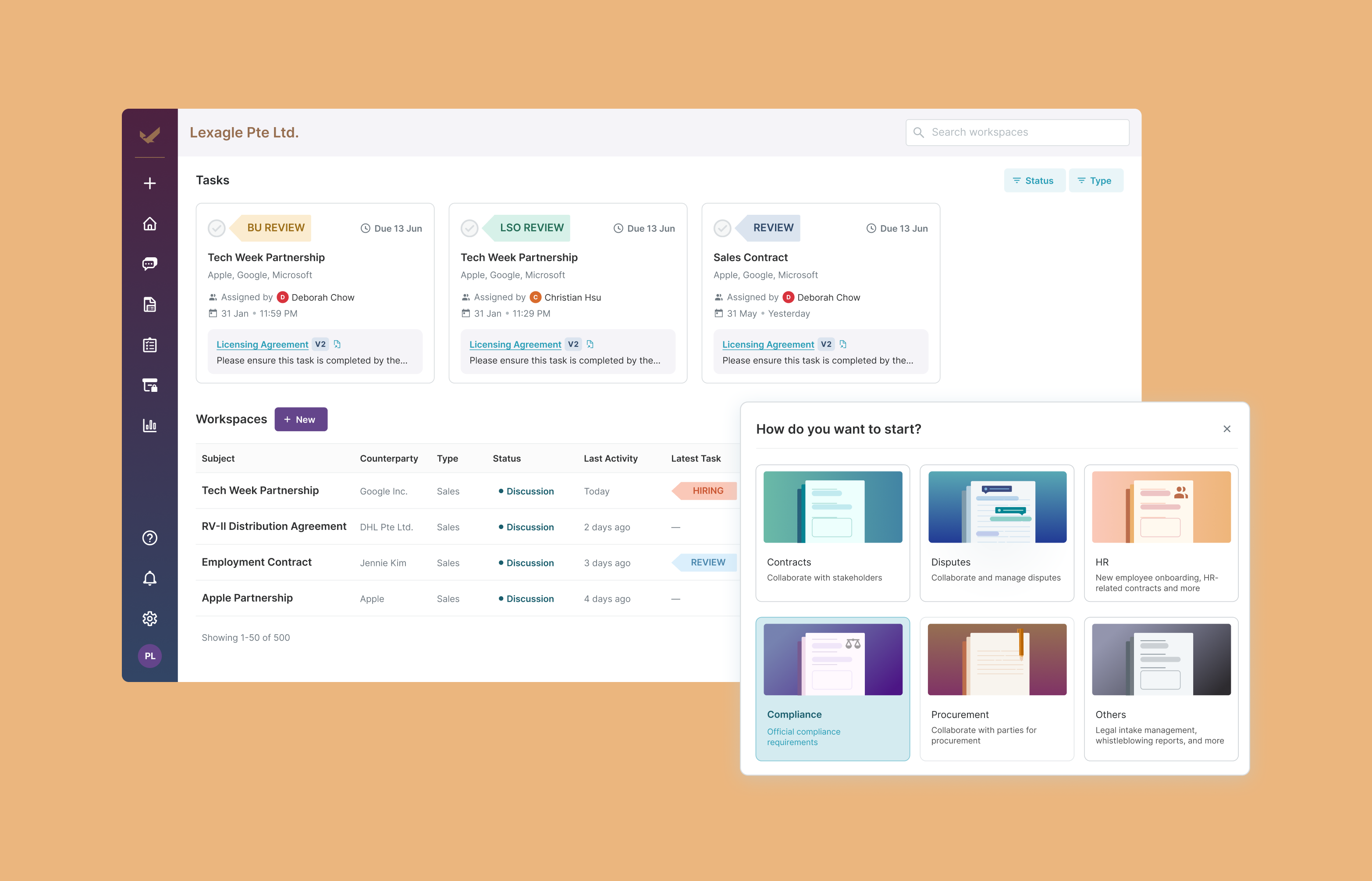
Problem
Legal teams were drowning in inefficiency. Email threads with 50+ replies for a single contract. Multiple versions of the same document scattered across drives. Pen-and-paper task tracking in 2019. Business teams pushing for speed while legal teams needed thoroughness.
The tools available were either too complex (enterprise solutions requiring months of training) or too simple (basic e-signature tools).
Key Discovery Activites
40+ Interviews Distilled into 3 Actionable Personas
①
Conducted extensive primary research including in-depth interviews with legal professionals across 4 countries and shadowing sessions observing actual contract workflows. Transformed insights into 3 distinct personas (Legal Counsel, Business User, External Party) that became the north star for every design decision.
Journey
- Started: 50+ scattered components, no documentation, constant design debates
- 6 months: Core visual foundations and component library established
- Year 1: Intent-based pattern framework implemented
- Now: 40+ components, 20+ intent patterns, 90% reusability, 4 designers using it
De-risked Development Through Early Validation
③
Validated core concepts before any development began, testing prototypes with 10 potential users to confirm our ideas resonated. Established usability testing throughout development and feedback sessions post-launch, reducing the risk of major pivots and ensuring continuous product improvement.
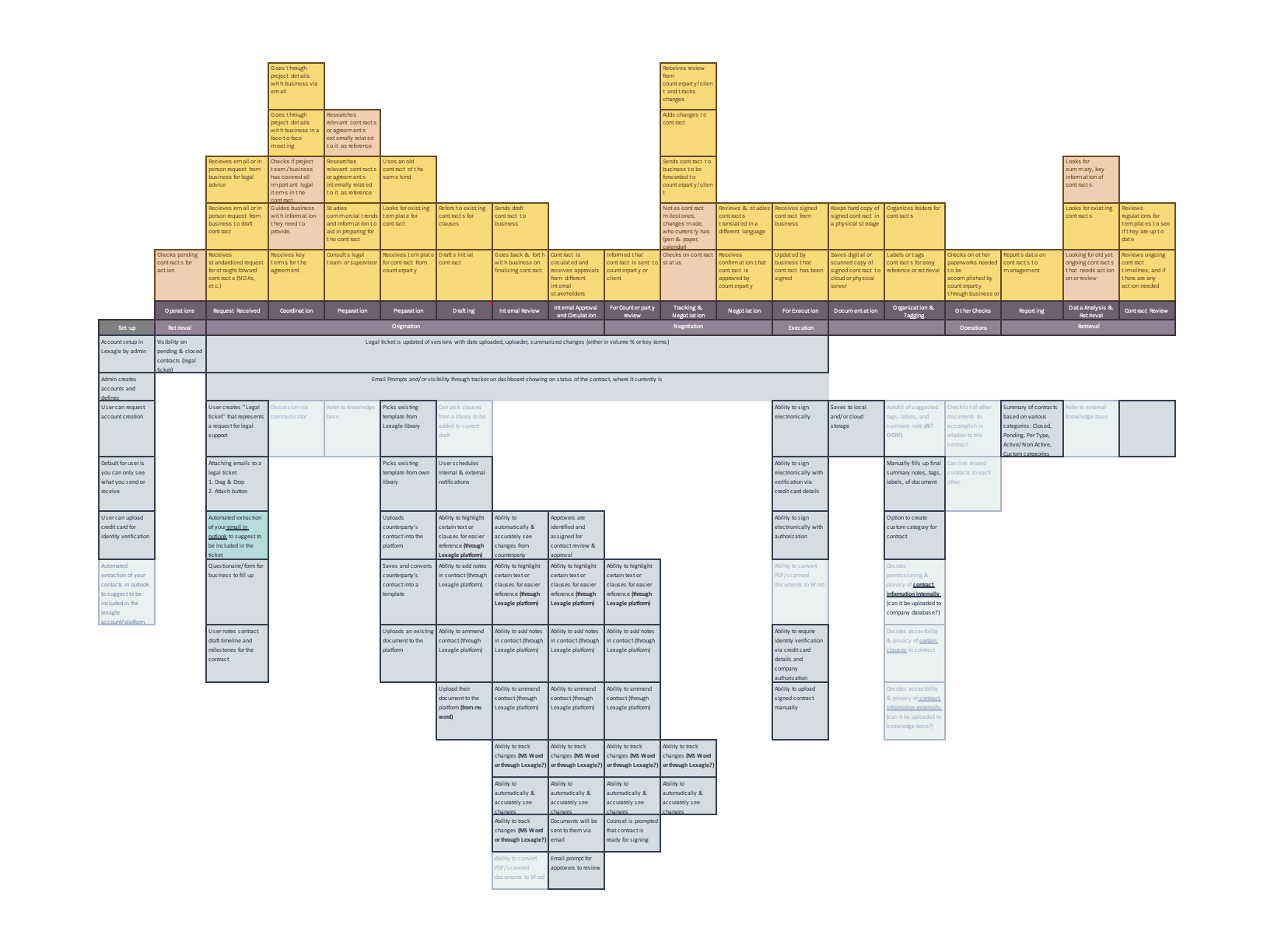
A Mental Model Map was one of the frameworks used to craft the MVP. It visually aligns what users are thinking, feeling, and doing (top section) with how a system or product can support those behaviors (bottom section). This structure helped identify gaps between user needs and system capabilities, guiding design and strategy for Lexagle.
Key Insight
Legal work is business work.
Legal teams don't work in silos—their work is triggered by business needs and requires constant collaboration. Yet most tools ignored this reality, creating friction between teams with different priorities. Our design needed to be the bridge: a shared workspace where legal's need for thoroughness could coexist with business's need for speed.
Core Platform Design
Collaboration Workspace
Three room types per matter: internal (team alignment), external (counterparty negotiation), and signing (execution). Real-time collaboration with version control, inline comments, and presence indicators—replacing endless email threads.
Dashboard
Role-based command center that surfaces what matters most—pending reviews for legal, deal progress for business, team metrics for managers. Smart prioritization ensures critical contracts never slip through cracks.
Signing
Transparent execution workflow where all parties track signing progress. Visual guides for signers, dependency management for complex agreements, and complete audit trail post-execution.
Templates
Pre-approved templates with smart fields and conditional logic let business users self-serve standard contracts while complex variations auto-route to legal. Drag-and-drop builder makes template creation intuitive, not technical.
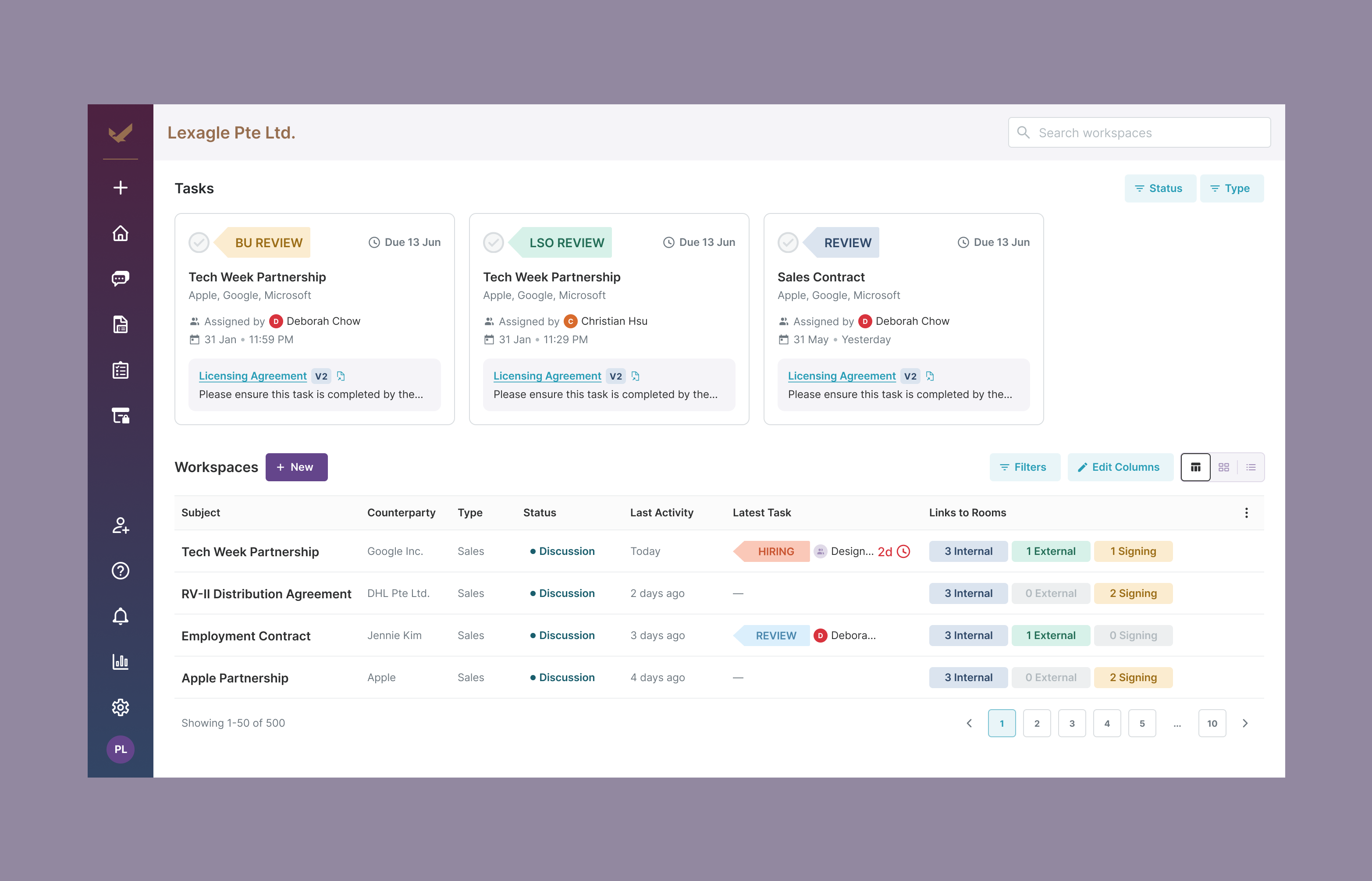
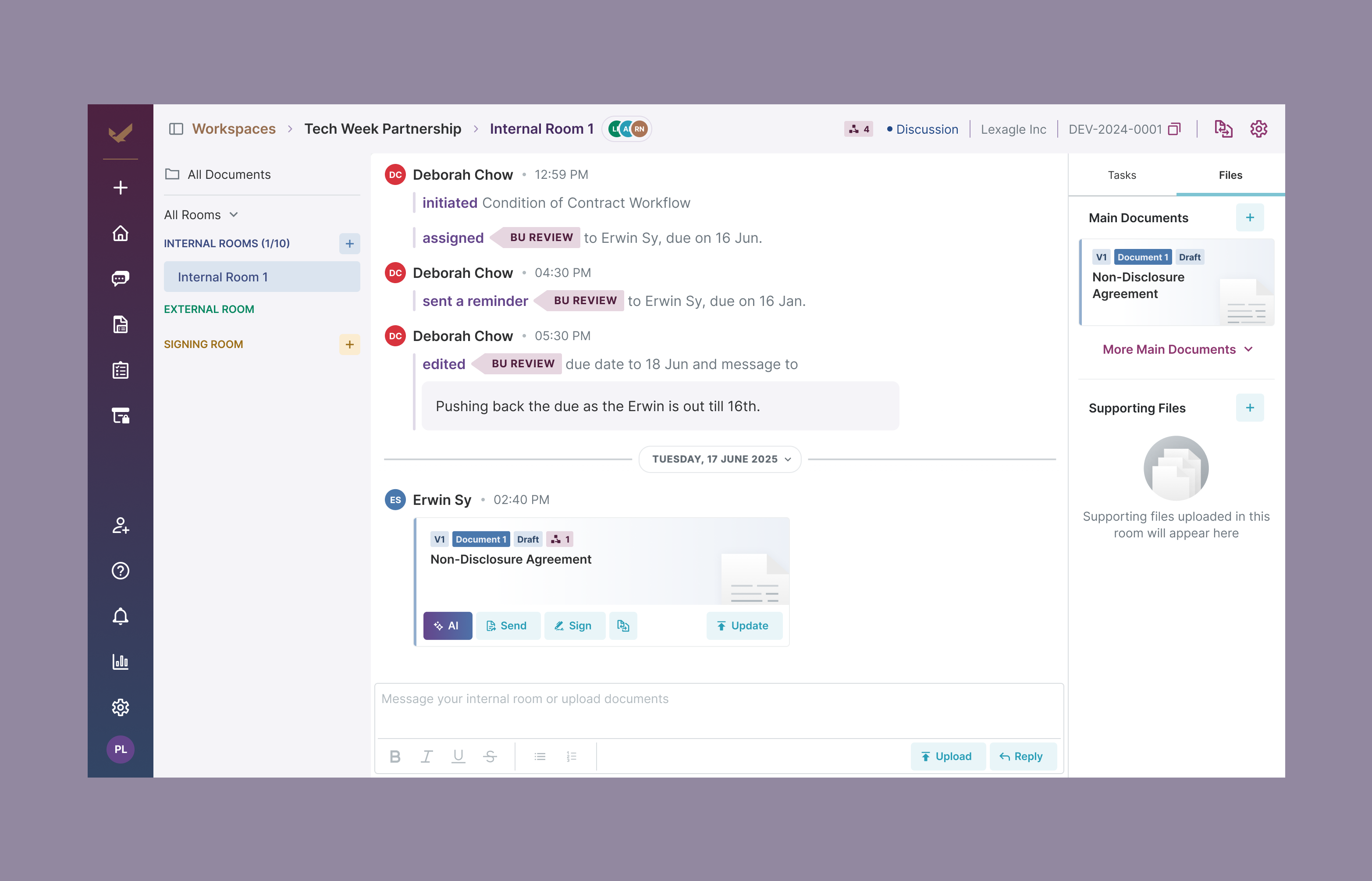
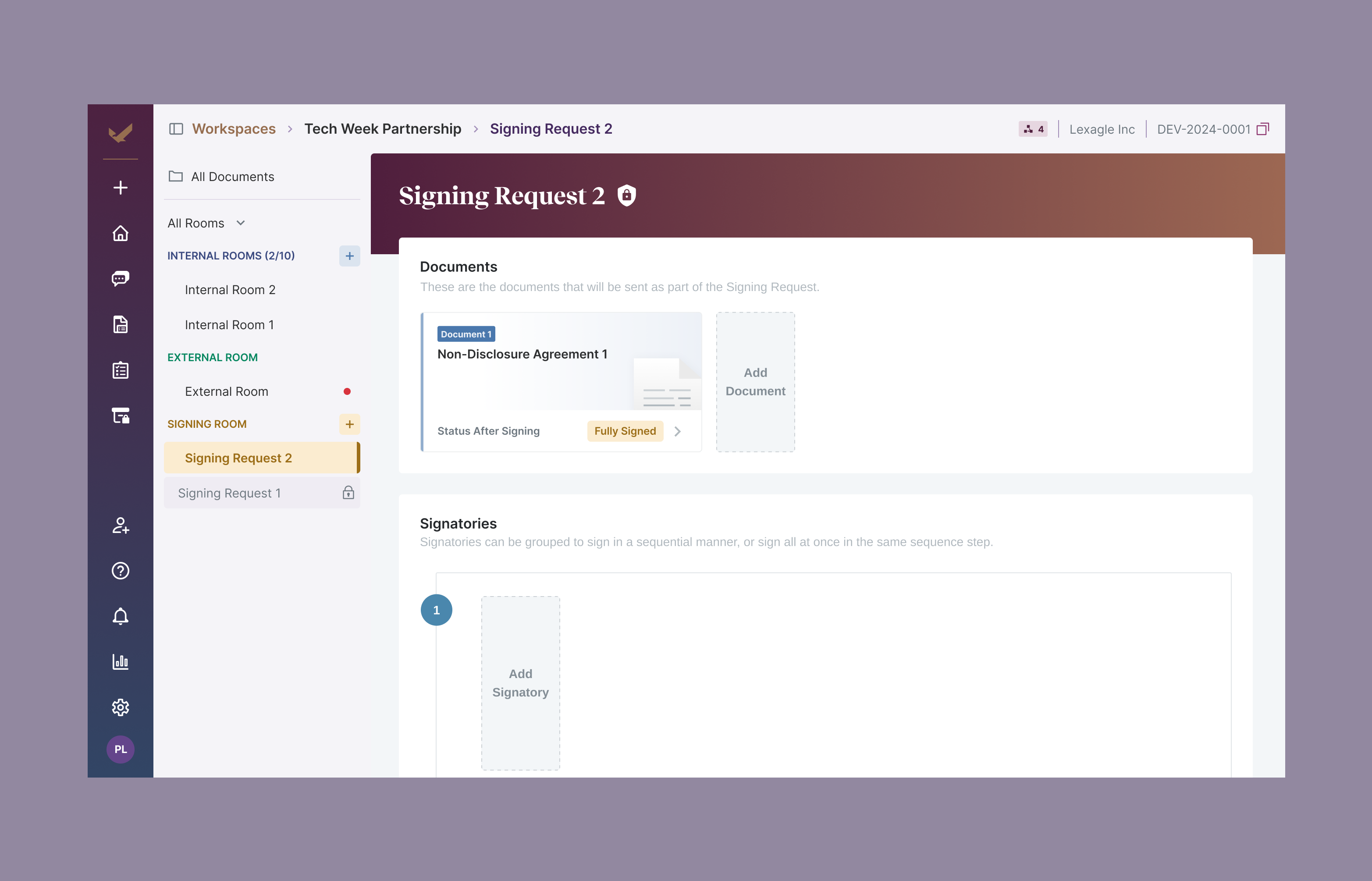
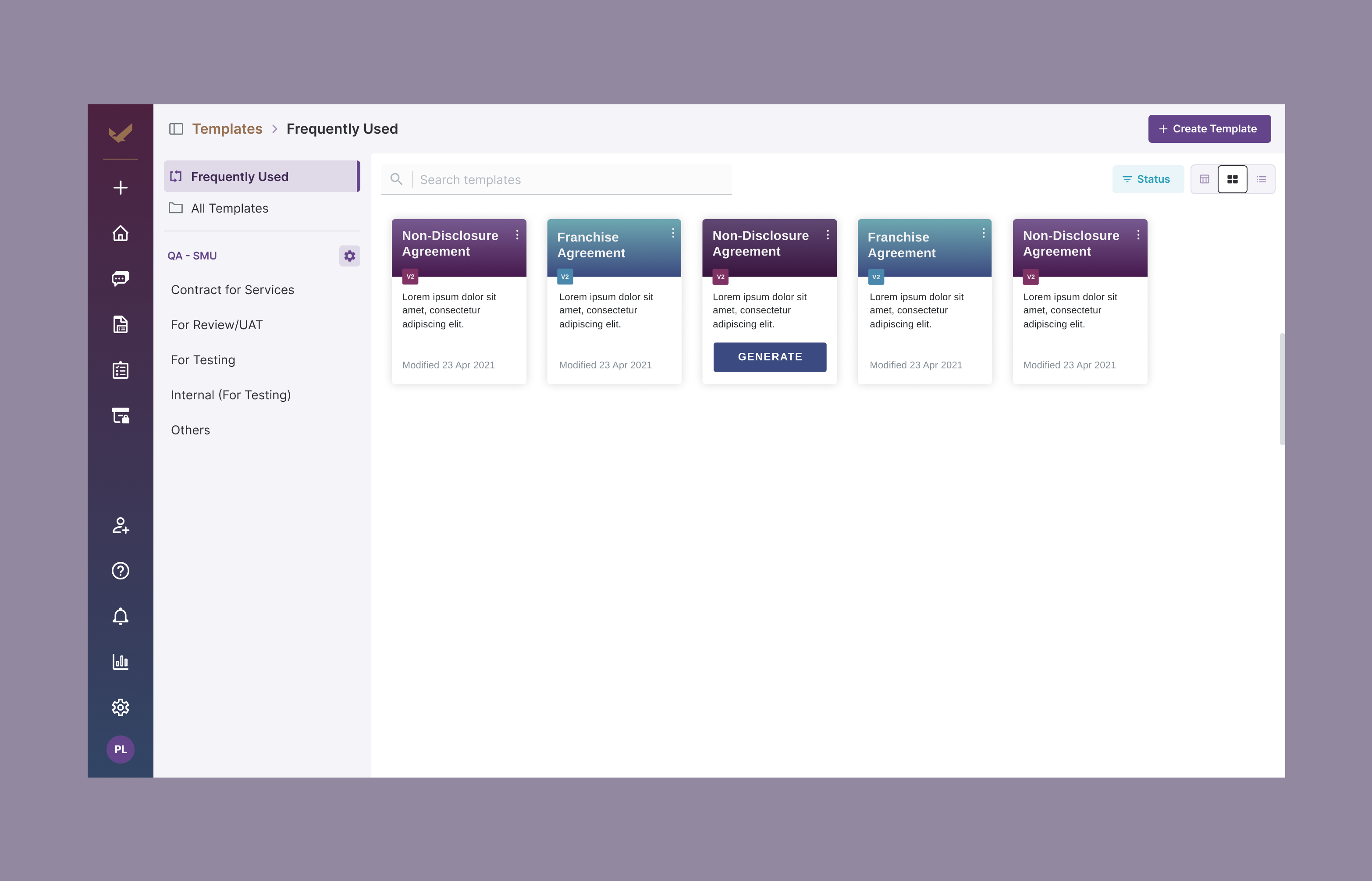
Design Strategy
Relationship-Centric
Contracts are about people, not documents. Every feature should strengthen stakeholder alignment.
Journey
- Started: 50+ scattered components, no documentation, constant design debates
- 6 months: Core visual foundations and component library established
- Year 1: Intent-based pattern framework implemented
- Now: 40+ components, 20+ intent patterns, 90% reusability, 4 designers using it
Simplify complexity
Through smart defaults and progressive disclosure—surface what truly matters & reveal the rest only when needed
The design principles later, post MVP, on evolved further where I added: (1) Craft moments of delight at key user milestones —celebrate meaningful moments and build emotional connection; (2) Guide focus through clear information hierarchy — every element should serve a clear purpose especially in relation with each other
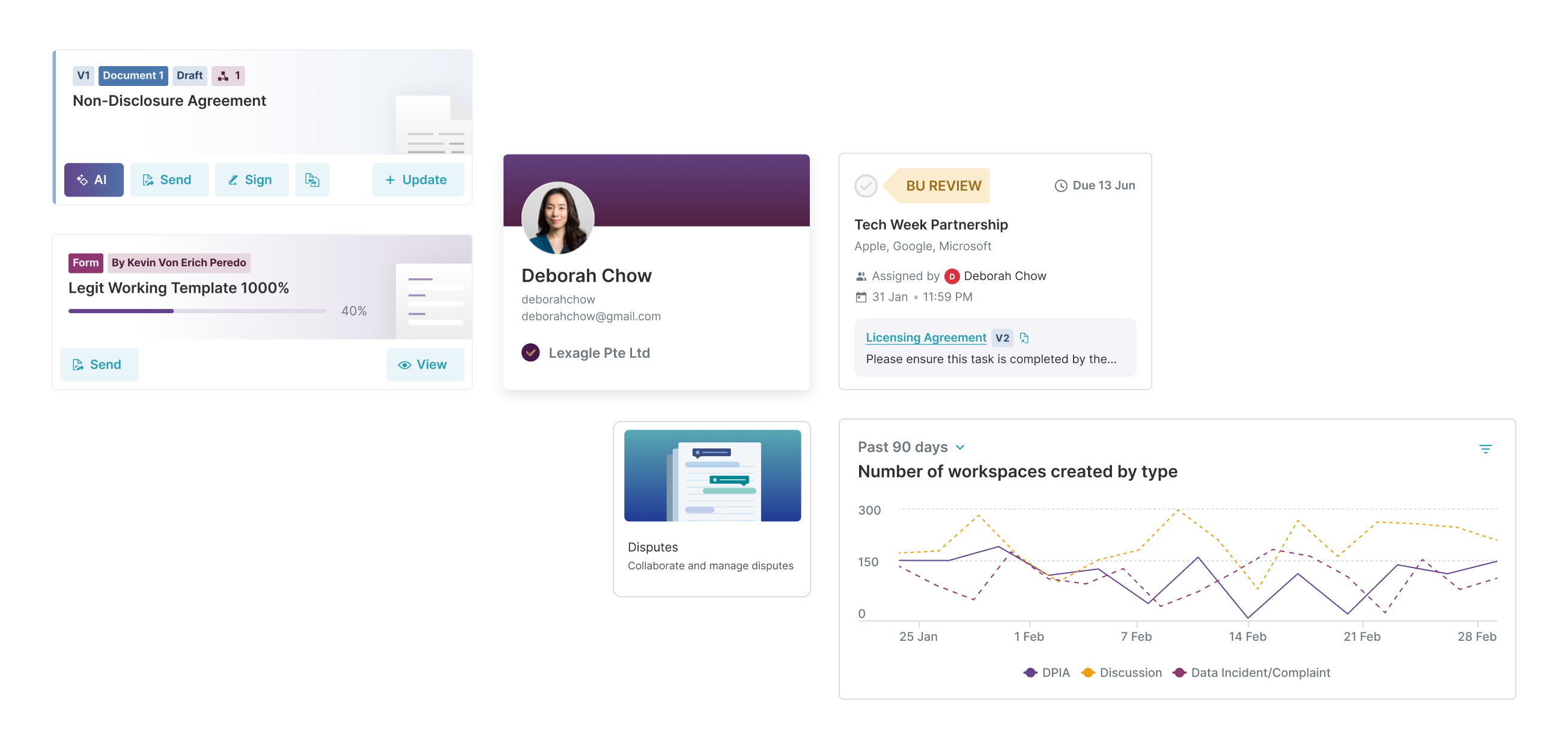
Moments of delight were captured through beautiful interfaces from familiar ones to never seen artifacts, to visualize something users thought could only be blocks of text: contract information.
Solution
The breakthrough was realizing complexity and simplicity aren't opposites—they're layers. Through progressive disclosure, business users see only what they need while legal professionals can unlock advanced features on demand. But the real innovation was transforming contracts from documents into relationships. Every feature brings stakeholders together in real-time collaboration rather than email silos. Combined with radical transparency—every change tracked, every version accessible, every decision logged—we built trust between teams who historically struggled to align. This approach let us serve enterprise clients without sacrificing simplicity: each configures their own workflows while the core experience remains clean and intuitive.
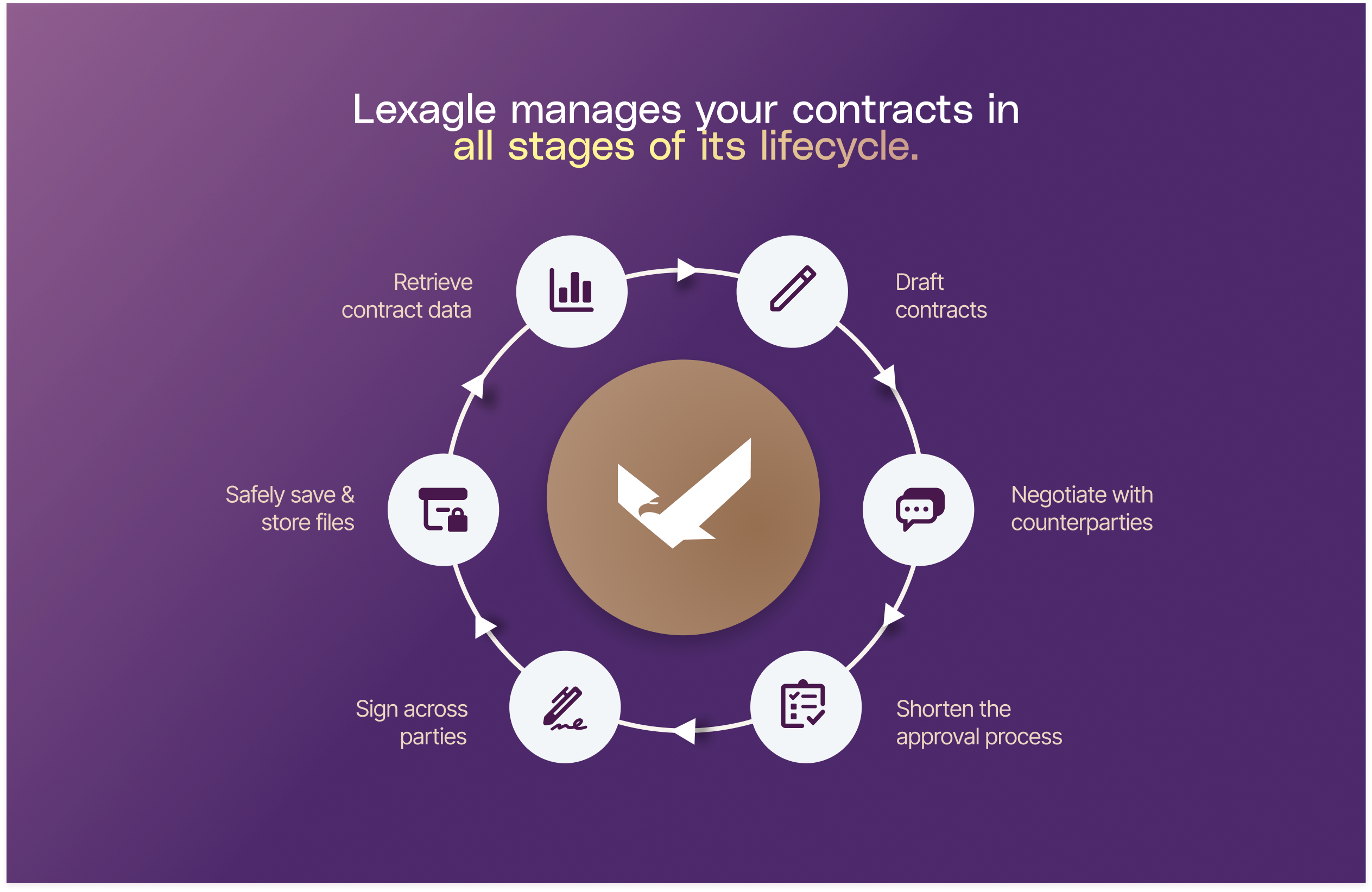
Impact
- 20+ enterprise clients across APAC
- 100% renewal rate
- 60% faster contract turnaround
- Team scaled from 1 to 10 designers
Key Learning
Enterprise software doesn't have to feel enterprise. By treating users as humans first, professionals second, we created a product they actually wanted to use.
Looking Back
What I Would Do Differently
- Invest in Design Champions Early: Identify and train power users within client organizations who could provide continuous feedback and advocate for the platform internally
- Document Everything from Day One: As the team grew, knowledge transfer became challenging. Should have established documentation practices early, not retroactively
- Build Design System on Proven Foundations: Instead of creating everything from scratch, leverage established libraries and extend them—would have saved months of effort
This intent-based approach fundamentally changed how we approach design at Lexagle. Instead of asking "What component should I use?" teams now ask "What is the user trying to accomplish?" This shift in thinking has created more thoughtful, user-centered interfaces that scale naturally with business complexity.
The framework continues to evolve, but the core principle remains: start with human intent, adapt to content complexity, and let patterns guide consistent execution. It's a approach that puts users at the center of every design decision.
Zero to One: Building a B2B SaaS Platform for Enterprise Legal Teams
My Role Founding designer responsible for research, UX, visual design, design systems, and eventually building and leading the design team.

Problem
Legal teams were drowning in inefficiency. Email threads with 50+ replies for a single contract. Multiple versions of the same document scattered across drives. Pen-and-paper task tracking in 2019. Business teams pushing for speed while legal teams needed thoroughness.
The tools available were either too complex (enterprise solutions requiring months of training) or too simple (basic e-signature tools).
Key Discovery Activites
①
40+ Interviews Distilled into 3 Actionable Personas
Conducted extensive primary research including in-depth interviews with legal professionals across 4 countries and shadowing sessions observing actual contract workflows. Transformed insights into 3 distinct personas (Legal Counsel, Business User, External Party) that became the north star for every design decision.
②
Business-User Alignment Through Strategic Stakeholder Mapping
Facilitated sessions with founders to map business objectives against user needs. This collaborative approach ensured product-market fit while balancing user experience with business viability—critical for a startup seeking enterprise clients.
③
De-risked Development Through Early Validation
Validated core concepts before any development began, testing prototypes with 10 potential users to confirm our ideas resonated. Established usability testing throughout development and feedback sessions post-launch, reducing the risk of major pivots and ensuring continuous product improvement.

A Mental Model Map was one of the frameworks used to craft the MVP. It visually aligns what users are thinking, feeling, and doing (top section) with how a system or product can support those behaviors (bottom section). This structure helped identify gaps between user needs and system capabilities, guiding design and strategy for Lexagle.
Key Insight
Legal work is business work.
Legal teams don't work in silos—their work is triggered by business needs and requires constant collaboration. Yet most tools ignored this reality, creating friction between teams with different priorities. Our design needed to be the bridge: a shared workspace where legal's need for thoroughness could coexist with business's need for speed.
Core Platform Design
Collaboration Workspace
Three room types per matter: internal (team alignment), external (counterparty negotiation), and signing (execution). Real-time collaboration with version control, inline comments, and presence indicators—replacing endless email threads.
Dashboard
Role-based command center that surfaces what matters most—pending reviews for legal, deal progress for business, team metrics for managers. Smart prioritization ensures critical contracts never slip through cracks.
Signing
Transparent execution workflow where all parties track signing progress. Visual guides for signers, dependency management for complex agreements, and complete audit trail post-execution.
Templates
Pre-approved templates with smart fields and conditional logic let business users self-serve standard contracts while complex variations auto-route to legal. Drag-and-drop builder makes template creation intuitive, not technical.




Design Strategy
Simplify complexity
Through smart defaults and progressive disclosure—surface what truly matters & reveal the rest only when needed
Relationship-Centric
Contracts are about people, not documents. Every feature should strengthen stakeholder alignment.
Trust Through Transparency
Every change tracked, every decision documented, every version accessible
The design principles later, post MVP, on evolved further where I added: (1) Craft moments of delight at key user milestones —celebrate meaningful moments and build emotional connection; (2) Guide focus through clear information hierarchy — every element should serve a clear purpose especially in relation with each other

Moments of delight were captured through beautiful interfaces from familiar ones to never seen artifacts, to visualize something users thought could only be blocks of text: contract information.
Solution
The breakthrough was realizing complexity and simplicity aren't opposites—they're layers. Through progressive disclosure, business users see only what they need while legal professionals can unlock advanced features on demand. But the real innovation was transforming contracts from documents into relationships. Every feature brings stakeholders together in real-time collaboration rather than email silos. Combined with radical transparency—every change tracked, every version accessible, every decision logged—we built trust between teams who historically struggled to align. This approach let us serve enterprise clients without sacrificing simplicity: each configures their own workflows while the core experience remains clean and intuitive.

Impact
- 20+ enterprise clients across APAC
- 100% renewal rate
- 60% faster contract turnaround
- Team scaled from 1 to 10 designers
Key Learning
Design systems aren't just about consistency—they're about encoding decision-making. By building intent and complexity into our system's DNA, we created a framework that makes designers faster while producing better outcomes for users with varying needs.
Looking Back
What I Would Do Differently
- Invest in Design Champions Early: Identify and train power users within client organizations who could provide continuous feedback and advocate for the platform internally
- Document Everything from Day One: As the team grew, knowledge transfer became challenging. Should have established documentation practices early, not retroactively
- Build Design System on Proven Foundations: Instead of creating everything from scratch, leverage established libraries and extend them—would have saved months of effort
This intent-based approach fundamentally changed how we approach design at Lexagle. Instead of asking "What component should I use?" teams now ask "What is the user trying to accomplish?" This shift in thinking has created more thoughtful, user-centered interfaces that scale naturally with business complexity.
The framework continues to evolve, but the core principle remains: start with human intent, adapt to content complexity, and let patterns guide consistent execution. It's a approach that puts users at the center of every design decision.
Zero to One: Building a B2B SaaS Platform for Enterprise Legal Teams
My Role Founding designer responsible for research, UX, visual design, design systems, and eventually building and leading the design team.

Problem
Legal teams were drowning in inefficiency. Email threads with 50+ replies for a single contract. Multiple versions of the same document scattered across drives. Pen-and-paper task tracking in 2019. Business teams pushing for speed while legal teams needed thoroughness.
The tools available were either too complex (enterprise solutions requiring months of training) or too simple (basic e-signature tools).
Key Discovery Activites
①
40+ Interviews Distilled into 3 Actionable Personas
Conducted extensive primary research including in-depth interviews with legal professionals across 4 countries and shadowing sessions observing actual contract workflows. Transformed insights into 3 distinct personas (Legal Counsel, Business User, External Party) that became the north star for every design decision.
②
Business-User Alignment Through Strategic Stakeholder Mapping
Facilitated sessions with founders to map business objectives against user needs. This collaborative approach ensured product-market fit while balancing user experience with business viability—critical for a startup seeking enterprise clients.
③
De-risked Development Through Early Validation
Validated core concepts before any development began, testing prototypes with 10 potential users to confirm our ideas resonated. Established usability testing throughout development and feedback sessions post-launch, reducing the risk of major pivots and ensuring continuous product improvement.

A Mental Model Map was one of the frameworks used to craft the MVP. It visually aligns what users are thinking, feeling, and doing (top section) with how a system or product can support those behaviors (bottom section). This structure helped identify gaps between user needs and system capabilities, guiding design and strategy for Lexagle.
Key Insight
Legal work is business work.
Legal teams don't work in silos—their work is triggered by business needs and requires constant collaboration. Yet most tools ignored this reality, creating friction between teams with different priorities. Our design needed to be the bridge: a shared workspace where legal's need for thoroughness could coexist with business's need for speed.
Core Platform Design
Collaboration Workspace
Three room types per matter: internal (team alignment), external (counterparty negotiation), and signing (execution). Real-time collaboration with version control, inline comments, and presence indicators—replacing endless email threads.
Dashboard
Role-based command center that surfaces what matters most—pending reviews for legal, deal progress for business, team metrics for managers. Smart prioritization ensures critical contracts never slip through cracks.
Signing
Transparent execution workflow where all parties track signing progress. Visual guides for signers, dependency management for complex agreements, and complete audit trail post-execution.
Templates
Pre-approved templates with smart fields and conditional logic let business users self-serve standard contracts while complex variations auto-route to legal. Drag-and-drop builder makes template creation intuitive, not technical.




Design Strategy
Simplify complexity
Through smart defaults and progressive disclosure—surface what truly matters & reveal the rest only when needed
Relationship-Centric
Contracts are about people, not documents. Every feature should strengthen stakeholder alignment.
Trust Through Transparency
Every change tracked, every decision documented, every version accessible
The design principles later, post MVP, on evolved further where I added: (1) Craft moments of delight at key user milestones —celebrate meaningful moments and build emotional connection; (2) Guide focus through clear information hierarchy — every element should serve a clear purpose especially in relation with each other

Moments of delight were captured through beautiful interfaces from familiar ones to never seen artifacts, to visualize something users thought could only be blocks of text: contract information.
Solution
The breakthrough was realizing complexity and simplicity aren't opposites—they're layers. Through progressive disclosure, business users see only what they need while legal professionals can unlock advanced features on demand. But the real innovation was transforming contracts from documents into relationships. Every feature brings stakeholders together in real-time collaboration rather than email silos. Combined with radical transparency—every change tracked, every version accessible, every decision logged—we built trust between teams who historically struggled to align. This approach let us serve enterprise clients without sacrificing simplicity: each configures their own workflows while the core experience remains clean and intuitive.

Impact
- 20+ enterprise clients across APAC
- 100% renewal rate
- 60% faster contract turnaround
- Team scaled from 1 to 10 designers
Key Learning
Enterprise software doesn't have to feel enterprise. By treating users as humans first, professionals second, we created a product they actually wanted to use.
Looking Back
What I Would Do Differently
- Invest in Design Champions Early: Identify and train power users within client organizations who could provide continuous feedback and advocate for the platform internally
- Document Everything from Day One: As the team grew, knowledge transfer became challenging. Should have established documentation practices early, not retroactively
- Build Design System on Proven Foundations: Instead of creating everything from scratch, leverage established libraries and extend them—would have saved months of effort
What Worked Well
- Deep Research Foundation: The initial 40+ interviews prevented major pivots and gave us conviction in our core decisions
- Workspace Metaphor: Users immediately grasped the concept without training—the mental model just clicked
- Continuous User Engagement: Regular check-ins with clients built trust and ensured we were solving real problems, not imagined ones